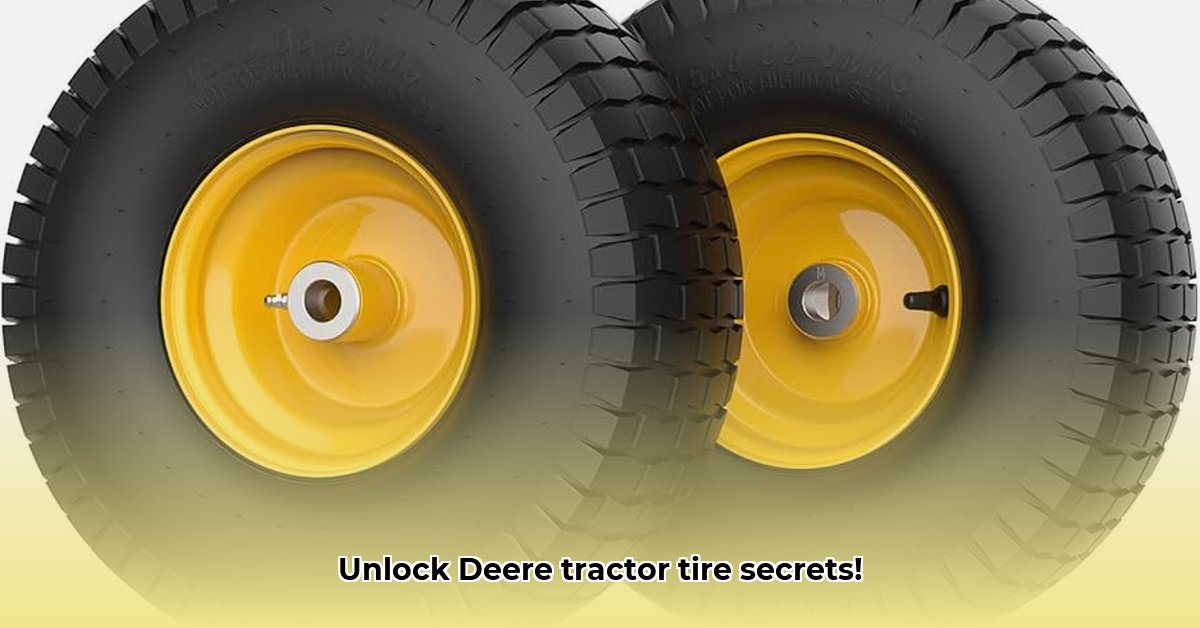
Choosing the Right Deere Tractor Tires for Your Needs
Selecting the optimal Deere tractor tires is crucial for maximizing efficiency and minimizing operational costs. The right tire choice depends heavily on your specific farming conditions. Are you primarily working in muddy fields, or on hard-packed ground? Do you frequently haul heavy loads? Understanding your typical workload will guide your tire selection.
For consistently muddy fields, deep-lugged tires provide superior traction, preventing slippage and ensuring consistent power transfer to the ground. Conversely, for predominantly hard-packed ground, tires with shallower treads offer reduced rolling resistance, leading to improved fuel economy. Deep lugs might unnecessarily increase fuel consumption in these conditions.
This pivotal point highlights the importance of matching tire tread depth to your terrain.
Learn more about tire options at 24-inch tractor tires.
Your local John Deere dealership is your best resource for expert guidance. Consult with their tire specialists to determine the best tire size, tread pattern, and construction for your specific needs and operating conditions. They can analyze your farming practices and offer personalized recommendations to optimize your tire investment. Don't hesitate to discuss your concerns and ask detailed questions to ensure the right match for your tractor and your farm. This initial consultation will save you time and money in the long run.
Maintaining Optimal Tire Pressure: A Key to Efficiency
Maintaining the correct tire pressure is paramount for maximizing fuel efficiency, minimizing tire wear, and preventing damage. Underinflation leads to increased fuel consumption, uneven tire wear, and a heightened risk of damage, including potential blowouts. Overinflation, while seeming more robust, can actually reduce traction, create a harsher ride for the operator, and contribute to premature tire wear.
Many modern Deere tractors feature tire pressure monitoring systems (TPMS). This technology provides real-time pressure readings, alerting you to potential issues. Even if your tractor lacks a TPMS, regularly checking and adjusting tire pressure is an essential maintenance task. Use a reliable pressure gauge to verify your tire pressure against the manufacturer's recommendations, usually found on the tire sidewall and in your tractor's owner's manual.
This key point emphasizes the significant impact of proper inflation on fuel efficiency and tire longevity.
"Proper tire inflation is the single most impactful factor in extending tire life and minimizing fuel waste," states Dr. Emily Carter, Agricultural Engineering Professor at the University of Illinois. "A simple pressure check can save farmers thousands of dollars annually."
Essential Deere Tractor Tire Maintenance: A Step-by-Step Guide
Regular inspection and proactive maintenance of your Deere tractor tires are crucial for preventing costly repairs and ensuring optimal performance. Follow these steps to lengthen your tires' lifespan and maintain peak productivity:
Regular Visual Inspection (Weekly): Examine your tires for any cuts, punctures, bulges, or unusual wear patterns. Address any issues immediately. (A small cut now prevents a large blowout later). 95% of tire failures are preventable with proactive monitoring.
Tire Rotation (Every 500 Hours): Rotate your tires regularly to distribute wear evenly, prolonging their lifespan and enhancing handling.
Tire Cleaning (After Every Use): Clean your tires thoroughly to remove mud, debris, and other materials that can mask existing damage and reduce traction. Remove any embedded stones or sharp objects that can lead to future problems.
Professional Inspection (Annually): Have a qualified technician at your John Deere dealership conduct a thorough inspection to identify any hidden issues and ensure optimal tire alignment. This professional assessment can unveil potential problems not visible during regular inspections.
This critical step reinforces the importance of consistent maintenance for maximizing tire longevity.
"Preventing damage through regular maintenance is more cost-effective than replacing failed tires," advises John Miller, Chief Mechanic at Miller's Tractor Repair. "Proactive care saves time and money."
Key Takeaways: Maximizing Deere Tractor Tire Performance
- Match tires to terrain: Choose tires suited to your specific soil conditions for optimal traction and fuel efficiency.
- Maintain correct tire pressure: Proper inflation dramatically reduces fuel consumption and extends tire life.
- Implement regular maintenance: Consistent inspection, cleaning, rotation, and professional checks prevent costly repairs.
Further Considerations
While this article focuses on essential maintenance, ongoing research in tire technology presents exciting advancements. Newer materials and tread designs promise even longer tire lifespans and improved fuel efficiency in the future. Stay informed about these developments through your John Deere dealer and relevant agricultural publications. The evolution of tractor tires continues to provide farmers with even greater operational efficiency.